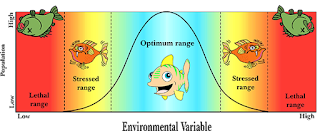Ecotype
- Dapatkan link
- X
- Aplikasi Lainnya
Ecotype
a group of similar populations within one and the same plant species that are adapted to certain climatic, edaphic, or cenoticconditions and that have developed, under these conditions, hereditary morphological, physiological, biochemical, and otherfeatures. Thus, an ecotype is isolated with respect to distribution; genotypically it is an intraspecific subdivision, whichdistinguishes it from a biotype.
The term “ecotype” was introduced in the 1920’s by the Swedish scientist G. Turesson. Different plants have different numbers of ecotypes. The ecotypic composition of a species becomes more varied as its geographic range and ecologicalamplitude increase. For example, 36 ecotypes have been distinguished in the pine Pinus silvestris and 27 in the sprucePicea abies. Ecotypic polymorphism is most clearly manifested at the center of speciation and morphogenesis. In themedic Medicago falcata, for example, there are many ecotypes in the Caucasus and only a few in the northern USSR.Parallel ecotypic differentiation is observed in many species. Thus, the wormwood Artemisia campestris, sheep sorrel(Rumex acetosella), and Silene uniflora, which grow in bright, dry habitats where there are strong winds, develop eco-typeswith procumbent stems.
Three main groups of ecotypes are distinguished: climatic, edaphic, and biotypic. Climatic, or geographic, ecotypes occupya separate part of the area of distribution of a species and originated under the influence of specific climatic conditions; forexample, in the awnless brome (Bromus inermis), the southern eco-type differs from the northern one by its nanism, narrowrough leaves, and wax coating. Edaphic ecotypes develop under the influence of soil and ground conditions, such as thepine ecotype on the chalky outcrops of the Don River, which has even been described as the independent species Pinuscretácea. Biotypic, or cenotic, ecotypes appear and develop mainly under the influence of plants together with which thegiven species form plant communities, for example, the field and forest ecotypes of the cocksfoot (Dactylis glomerata) andthe forest and dune ecotypes of the narrow-leaved hawkweed (Hieracium umbellatum).
The development of an ecotype is a lengthy process. If an ecotype has progressive characteristics, which permit it toextend the range of the species, it may give rise to a new species, and consequently an ecotype is one of the stages in theprocess of specia-tion.
REFERENCES
Sinskaia, E. N. Dinamika vida. Moscow-Leningrad, 1948.Zavadskii, K. M. Uchenie o vide. Leningrad, 1961.
Korchagin, A. A. “Vnutrividovoi (populiatsionnyi) sostav rastitel’nykh soobshchestv i metody ego izucheniia.” In the bookPolevaia geobotanika, vol. 3. Moscow-Leningrad, 1964.
- Dapatkan link
- X
- Aplikasi Lainnya



Komentar
Posting Komentar